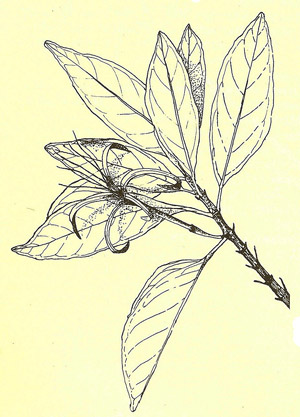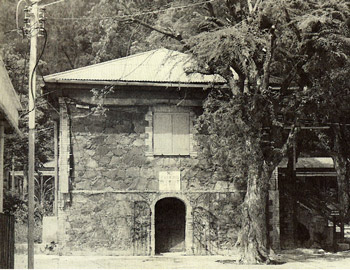Fever
 Leaves and distinctive flower of the Princewood Tree… an evergreen, 10-25 feet tall and to 4 inches in trunk diameter.
Leaves and distinctive flower of the Princewood Tree… an evergreen, 10-25 feet tall and to 4 inches in trunk diameter.
At the turn of the eighteenth century, Hans West, also on St. Croix, said: . “The vapors of this rainy season and the resulting cold air are what cause the many fevers that prevail toward the end of the year. Traveling through the island after sunset or before sunrise is therefore risky to one’s health, especially in a damp year… until the sun appears and dissolves or attenuates the heavy vapors.”As I mentioned last year in an article on rainfall, the residents of earlier centuries recognized a connection between fever and rainy weather, wetlands, swamps, light clothing and going out in the evenings and early mornings but they never made the real connection: to mosquitoes. One creative theory put forth asserted that the extreme heat of the summertime actually opened the pores of the skin to a large degree, then the cool rains of fall produced unwholesome vapors that entered these enlarged pores that hadn’t had time to revert to their protective closed state. It was best to cover the body in wool garments to guard that vulnerable skin. They were actually on to something there… woolen underwear would certainly guard pretty well against mosquito bites.Quinine, extracted mainly from a South American tree in the coffee family, Cinchona officinalis, came into world-wide use as an effective malaria remedy by the late 18th century. The bark of a closely related tree, Exostema caribaea, princewood, a common native tree in the VI, was also used locally, and apparently worked well. Elsewhere in the region it is still called fever tree and Jesuit bark. Hans West sent a sample of princewood bark to Denmark for testing in 1790; the Regimental Surgeon “found the effect to be reliable”.In spite of available malaria treatments, fevers continued to take a large toll on the local population up through the nineteenth century. The St. Thomas sanitary report for the 4th Quarter of 1887, for instance, lists 436 cases of “intermittent and remittent fever” reported by doctors in those 3 months, and 24 people died of those fevers, a figure matched only by “consumption” – tuberculosis. This was in an island population of about 15,000.By the time the mosquito/disease connection was figured out, in the years before transfer, the Danes weren’t especially interested in devoting resources to disease eradication. Periodic outbreaks continued to take lives into the early 1930’s. Then, U.S. President Herbert Hoover removed the USVI from the naval rule that had been in effect since transfer, and gave control to the Department of the Interior, installing the first US civilian Governor, Paul M. Pearson. Medical facilities, such as they were, on St. Thomas and St. John were directed by the brilliant Danish doctor Knud Knud-Hansen. When the Navy medical officers all had left the islands, a desperate Dr. Knud-Hansen dragged his former colleague Dr. Viggio Christensen out of happy retirement in the St. Thomas countryside to assist him.
 “Old” Hospital, Charlotte Amalie
“Old” Hospital, Charlotte Amalie
In 1932, a terrible epidemic of malaria hit St. Thomas and St. John. With the support of Governor Pearson, Dr. Knud-Hansen put every case in St. Thomas in the hospital, and Dr. Christensen came over to St. John, walking and riding to all the far-flung little settlements of the island to find every single resident, test everyone’s blood and put all the infected cases under treatment.Governor Pearson obtained “magnificent” federal appropriations to drain and fill wetlands on St. Thomas, including the huge Mosquito Bay swamp west of town. The large flat area of land that was created there was quickly converted to an airfield, known then as Bourne Field, and the bay was officially renamed Lindberg Bay. (Charles Lindberg had landed the“ Spirit of St. Louis” in St. Thomas in 1929, but it was actually on the other side of town, in the then empty expanse of Sugar Estate.)Dr. Knud-Hansen and Dr. Christensen were wildly successful. Malaria has not been known to occur as a locally generated disease in the Virgin Islands since that fateful outbreak of 1932. A vaccine eliminated yellow fever, but dengue is still very much with us. On the bright side, we no longer feel compelled to cover our bodies in several layers of thick woolen cloth to repel the noxious-and potentially fatal-vapors of the evening… Although the clouds of mosquitoes may seem just as insidious.
